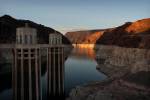Groundwater project will protect Southern Nevada
I was struck by a recent article in The Atlanta Journal-Constitution regarding that community's struggle with a severe drought-induced water shortage, in which Georgia's Environmental Protection division director summarized the crisis by lamenting, "All our eggs are in one basket."
You see, metro Atlanta's 3 million-plus residents depend upon a single water supply -- the Lanier River -- for their domestic water needs. And that single source is mired in an unprecedented drought.
Sound familiar? We are fortunate compared with Atlanta, because we have spent the better part of two decades amassing water reserves and working to develop an independent water supply within Nevada. As challenging as it is to meet our community's water needs, I do not envy the decisions facing a city that houses one-third of Georgia's residents. They are staring at a full-blown emergency. We in the American Southwest often talk about water resource challenges as though we are unique; the truth is that -- according to another recently published article -- 36 of the 50 United States will face water shortages in the near future, along with the many other countries already grappling with this situation.
Some claim that the Southern Nevada Water Authority's request to bring unused, renewable groundwater resources from east-central Nevada to our community is a sacrifice at the alter of growth. While we certainly recognize that people continue to migrate to Southern Nevada, and that over time our water needs will continue to increase even with increased efficiency, the plain truth is that we cannot afford to have all of our eggs in one basket. Even if not another person moved to the valley, we would need an independent water supply to protect us from drought on the Colorado River, which has already reached its eighth year.
It is common for metropolitan areas to import water to ensure a reliable water supply, often from great distances. In New York City, the Hudson River can support only a fraction of its population -- many of the city's 7 million people rely upon water from upstate New York. This is true for both major U.S. cities -- including San Francisco, San Diego and Phoenix -- and communities within our own state, such as Carson City, Virginia City, Wendover, Tonopah, Lovelock and Eureka. The concept that available water should go where it is needed most is not a new one.
So who determines how much water is available? For those unfamiliar with our state's water law, it works like this: Based upon an area's hydrology, the Nevada state engineer determines how much water is available annually for use in that groundwater basin. Existing permitted uses are then deducted from that amount. Water rights are granted on a first-come, first-served basis. Because water rights are seniority-based, newly granted water rights cannot by law unreasonably infringe upon existing rights. If someone wants to export their water rights out of the basin -- which happens frequently in Nevada -- there are additional restrictions to protect the basin of origin.
Should Nevada's ranchers have to give up their water rights to the Las Vegas Valley? Of course not. But is it reasonable to try to deny our community the right to draw upon other available water in the area? Again, the answer is no. Some in the environmental community are concerned about how withdrawing this available water will affect wildlife and the habitat that supports it. While we agree that this resource must be carefully managed, both Nevada water law and federal environmental laws recognize the importance of responsible and tightly controlled water use. Groundwater use and environmental stewardship are not mutually exclusive, and the Southern Nevada Water Authority has long been recognized for its responsible environmental practices.
According to the National Groundwater Association, 46 percent of Americans use groundwater for their drinking water supply, drawing approximately 16 billion gallons per day. They manage to do this year after year without destroying the surrounding environment.
The National Geographic Society estimates that our country's groundwater reserves total more than 33 quadrillion gallons -- more than 20 times the combined total of the United States' rivers, lakes and streams. Although Nevada is certainly more arid than most states, Snake Valley's annual "water budget" -- calculated largely based upon the amount of snowmelt that seeps into the ground -- is estimated to be 40 billion gallons per year. Southern Nevada hopes to develop approximately one-third of that, despite the fact that the U.S. Geological Survey estimated that approximately 80 percent of the natural recharge in this shared basin-- which is bisected by the Utah-Nevada state line -- emanates from our state.
This basin's water will inevitably be put to use by someone, either here or in Southern Utah, where applications for interbasin transfers from the same area and for a like amount have been filed. Nevada's residents are entitled to our state's fair share of this resource.
There is absolutely no question that this new supply must be managed in an environmentally responsible manner. But there is also no question that this new source must be developed if we are to avoid Atlanta's fate.
Patricia Mulroy is general manager of the Southern Nevada Water Authority.























